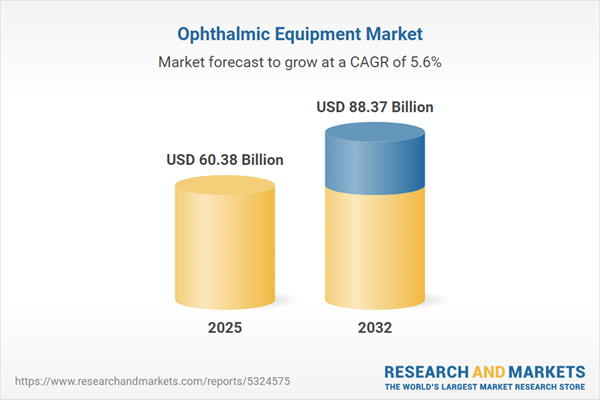Speak directly to the analyst to clarify any post sales queries you may have.
The ophthalmic equipment market offers significant opportunities for forward-looking healthcare organizations, as digital solutions and advanced diagnostic technologies substantially reshape clinical, operational, and procurement landscapes. Senior leaders increasingly prioritize equipment investments that drive efficiency and enable adaptive strategies in a rapidly evolving care environment.
Market Snapshot: Ophthalmic Equipment Market Growth Overview
The ophthalmic equipment market grew from USD 57.14 billion in 2024 to USD 60.38 billion in 2025 and is forecast to reach USD 88.37 billion by 2032, with a compound annual growth rate of 5.60%. Expansion in this sector is supported by strategic investments in digital diagnostic platforms and artificial intelligence, which are improving care pathways and streamlining clinical workflows. Changing demographic trends and evolving patient expectations further motivate organizations to adopt innovative technologies, building the foundation for more personalized, preventative, and data-driven eye health solutions.
Scope & Segmentation: Strategic Perspectives for Senior Decision-Makers
The ophthalmic equipment market features diverse segments, each with clear implications for innovation, procurement, and executive leadership. Understanding these categories is crucial for aligning resources and growth strategies.
- Product Types: Autorefractors, keratometers, ophthalmoscopes, optical coherence tomography systems, pachymeters, phoropters, retinal imaging systems, slit lamps, specular microscopes, surgical microscopes, tonometers, and visual field analyzers address a broad spectrum of diagnostic and therapeutic needs in ophthalmology.
- Application Areas: Solutions support cataract and glaucoma care, diabetic retinopathy management, laser vision correction, myopia control, and comprehensive retinal diagnosis, enabling both prevention and targeted intervention.
- End Users: Ambulatory surgical centers, eye clinics, hospitals, diagnostic labs, and research organizations deliver ophthalmic care at varied scales, highlighting the importance of versatile equipment portfolios.
- Distribution Channels: Direct procurement, distributor partnerships, and digital platforms drive inventory flexibility and speed, improving supply responsiveness in a dynamic market.
- Portability: Benchtop and portable devices support standard and teleophthalmology care settings, helping extend reach into remote and underserved communities.
- Key Geographic Regions: The Americas, Europe, Middle East & Africa, and Asia-Pacific offer a spectrum of regulatory requirements and readiness for technology adoption, affecting access, uptake, and competitive differentiation.
- Representative Companies: Carl Zeiss Meditec AG, Alcon Inc., Johnson & Johnson Vision Care, Bausch + Lomb Corporation, Topcon Corporation, NIDEK, and Canon Inc. are recognized for significant R&D investments and responsive business strategies.
Key Takeaways for Strategic Market Positioning
- Artificial intelligence is advancing diagnostic precision, enabling more proactive and efficient patient management in ophthalmology.
- Growth in mobile and portable ophthalmic technology brings substantial gains in access, supporting virtual care programs and expanding outreach.
- Streamlined regulatory pathways accelerate availability of new technologies, shortening development cycles and increasing clinical adoption speed.
- Collaboration and alliances among providers and technology developers enhance portfolio breadth and support adjustments to changing patient care models.
- Advanced digital integration enables organizations to tailor care delivery, optimize resources, and remain flexible in the face of new industry trends.
- Fortifying supply chains through diversified sourcing and process automation is a priority, minimizing risks from external pressures and evolving regulation.
Tariff Impact on Cost Management and Supply Chain Strategy
Recent U.S. tariff changes have led to rising component costs within the ophthalmic equipment sector. In response, businesses are improving sourcing flexibility through supplier diversity, automating procurement, and considering nearshoring approaches. Strategic licensing and collaborative agreements also help maintain regulatory compliance and sustained access across global supply networks, supporting resilience amid continual change.
Methodology & Data Sources
This report is based on interviews with industry executives, procurement specialists, and subject matter experts, ensuring actionable and industry-relevant insights. Data is drawn from leading research providers, industry publications, and associations, with economic and clinical viewpoints supplying further context for evidence-based recommendations.
Why This Report Matters
- Delivers in-depth intelligence on emerging ophthalmic technologies and business practices, allowing executive leadership to anticipate and address future needs.
- Equips senior leaders to make informed decisions across innovation, regulatory engagement, and supply chain management, strengthening operational agility and competitive stance.
- Provides a foundation for establishing strategic partnerships and deploying scalable, compliant care solutions in the evolving healthcare space.
Conclusion
With a comprehensive analysis of technology, strategy, and supply dynamics, this report supports senior decision-makers in advancing innovation and organizational resilience amid ongoing change in global ophthalmic care.
Additional Product Information:
- Purchase of this report includes 1 year online access with quarterly updates.
- This report can be updated on request. Please contact our Customer Experience team using the Ask a Question widget on our website.
Table of Contents
3. Executive Summary
4. Market Overview
7. Cumulative Impact of Artificial Intelligence 2025
Companies Mentioned
The companies profiled in this Ophthalmic Equipment market report include:- Carl Zeiss Meditec AG
- Alcon Inc.
- Johnson & Johnson Vision Care, Inc.
- Bausch + Lomb Corporation
- Topcon Corporation
- NIDEK Co., Ltd.
- Canon Inc.
- Heidelberg Engineering GmbH
- Haag-Streit Holding AG
- Optovue, Inc.
Table Information
| Report Attribute | Details |
|---|---|
| No. of Pages | 191 |
| Published | November 2025 |
| Forecast Period | 2025 - 2032 |
| Estimated Market Value ( USD | $ 60.38 Billion |
| Forecasted Market Value ( USD | $ 88.37 Billion |
| Compound Annual Growth Rate | 5.6% |
| Regions Covered | Global |
| No. of Companies Mentioned | 11 |









